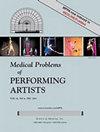职业舞者在有或没有疼痛的情况下的感觉感受性:一项横断面研究。
IF 0.7
4区 医学
Q3 MEDICINE, GENERAL & INTERNAL
引用次数: 0
摘要
背景越来越多的文献研究了使用手法治疗通过内感受途径调节疼痛,但缺乏对舞者群体的研究。目的调查生活在有或没有疼痛的职业舞者的内感受性(IAs)的自我报告测量,并探索IAs与混杂变量(如精神病理学)之间的联系。疼痛状况是自我报告的,参与者被分为三个研究组进行分析(无痛n=26,急性n=30,慢性疼痛n=72)。感觉知觉的多维评估,第2版(MAIA-2)用于测量IAs。另一份问卷用于收集人口统计学和假定的混杂数据(即年龄、性别、BMI、舞蹈风格、就业状况、经验水平、正念体验、疼痛史和管理,如手动治疗的使用、饮食失调、抑郁和焦虑)(无痛控制、急性和慢性疼痛)。单因素方差分析显示,与无疼痛对照组相比,患有疼痛(急性或慢性)的舞者的MAIA-2非分心分量表得分显著较低。此外,在人群中发现手动治疗的使用和MAIA-2的一些分量表之间存在关联。结论应谨慎解释结果,因为主要的混杂变量(即精神病理学)在样本中的患病率很高,因此不能从分析中排除。MAIA-2的适应性分量表与手动治疗的使用之间的正相关支持了进一步研究的必要性,研究使用内感受通路在专业治疗舞者疼痛中的潜在临床应用。本文章由计算机程序翻译,如有差异,请以英文原文为准。
Interoceptive Sensibility in Professional Dancers Living With or Without Pain: A Cross-Sectional Study.
BACKGROUND
There is a growing body of literature investigating the use of manual therapy to modulate pain through interoceptive pathways, but studies amongst the dancer population are lacking.
OBJECTIVES
To investigate self-reported measures of interoceptive sensibility (IAs) in professional dancers living with or without pain, and to explore associations between IAs and confounding variables (e.g., psychopathologies).
METHODS
128 UK-based adult professional dancers, from any dance style, living with or without pain, completed a cross-sectional online survey. Pain status was self-reported and participants were assigned in three study groups for analyses (pain-free n=26, acute n=30, and chronic pain n=72). The Multidimensional Assessment of Interoceptive Awareness, ver. 2 (MAIA-2) was used to measure IAs. An additional questionnaire was used to collect demographic and putative confounding data (i.e., age, sex, BMI, dance style, employment status, level of experience, mindfulness experience, pain history and management such as manual therapy use, eating disorders, depression, and anxiety).
RESULTS
No overall significant difference was found in IAs between groups (pain-free-control, acute, and chronic pain). A one-way ANOVA showed significantly lower scores for the MAIA-2 Non-Distracting subscale in dancers living with pain (acute or chronic) compared to the pain-free-control group. Moreover, an association between manual therapy use and some subscales of the MAIA-2 was found in the population.
CONCLUSIONS
Results should be interpreted with caution, as major confounding variables (i.e., psychopathologies) could not be excluded from the analysis due to their high prevalence in the sample. Positive associations between adaptive subscales of the MAIA-2 and the use of manual therapy support a need for further research investigating potential clinical applications using interoceptive pathways in the specialised management of pain in dancers.
求助全文
通过发布文献求助,成功后即可免费获取论文全文。
去求助
来源期刊
CiteScore
1.60
自引率
22.20%
发文量
28
审稿时长
>12 weeks
期刊介绍:
Medical Problems of Performing Artists is the first clinical medical journal devoted to the etiology, diagnosis, and treatment of medical and psychological disorders related to the performing arts. Original peer-reviewed research papers cover topics including neurologic disorders, musculoskeletal conditions, voice and hearing disorders, anxieties, stress, substance abuse, and other health issues related to actors, dancers, singers, musicians, and other performers.

 求助内容:
求助内容: 应助结果提醒方式:
应助结果提醒方式:


